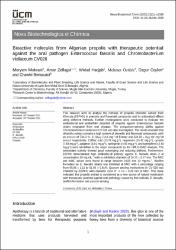Bioactive molecules from Algerian propolis with therapeutic potential against the oral pathogen Enterococcus faecalis and Chromobacterium violaceum CV026
Abstract
This research aims to analyse the richness of propolis ethanolic extract from Kherrata (EEPKh) in phenolic and flavonoid compounds and its antioxidant effects using different methods. Further investigations were conducted to evaluate the antibacterial and antibiofilm potential of propolis against Enterococcus faecalis strains originated from oral diseases. The antiquorum-sensing ability against Chromobacterium violaceum CV 026 was also investigated. The results revealed that ethanolic extract contains a high content of phenolic and flavonoid compounds, with an amount of 734.3 9± 11.54µg GAE.mg-1 of Extract and 224.30 ± 0µg QE.mg-1of extract respectively. Caffeic acid (23.79 mg.g-1), hesperetin (15.42 mg.g-1), cynarin (7.59 mg.g-1), apigenin (5.91 mg.g-1), naringenin (4.90 mg.g-1), and kaempferol (3.43 mg.g-1) were identified as the major compounds by the HPLC-DAD analysis. The antioxidant activity showed good scavenging and reducing abilities. Furthermore, EEPKh demonstrated high antibacterial potency against E. faecalis strain 2 at concentration 20 mg.mL-1 with an inhibition diameter of 20.33 ± 0.57 mm. The MIC and MBC values were found to range between 0.625 and 10 mg.mL-1. Biofilm formation by E. faecalis strains was inhibited at MIC with a percentage ranging from 65.93 ± 1.11 to 51.54 ± 0.81%. Quorum sensing mechanisms in CV 026 was inhibited by EEPKh, with diameter zone of 11.16 ± 0.29 mm at MIC. This study indicated that propolis extract is considered as a new source of natural medication with therapeutic potential against oral pathology caused by free radicals, E. faecalis, biofilm formation and quorum-sensing.


















